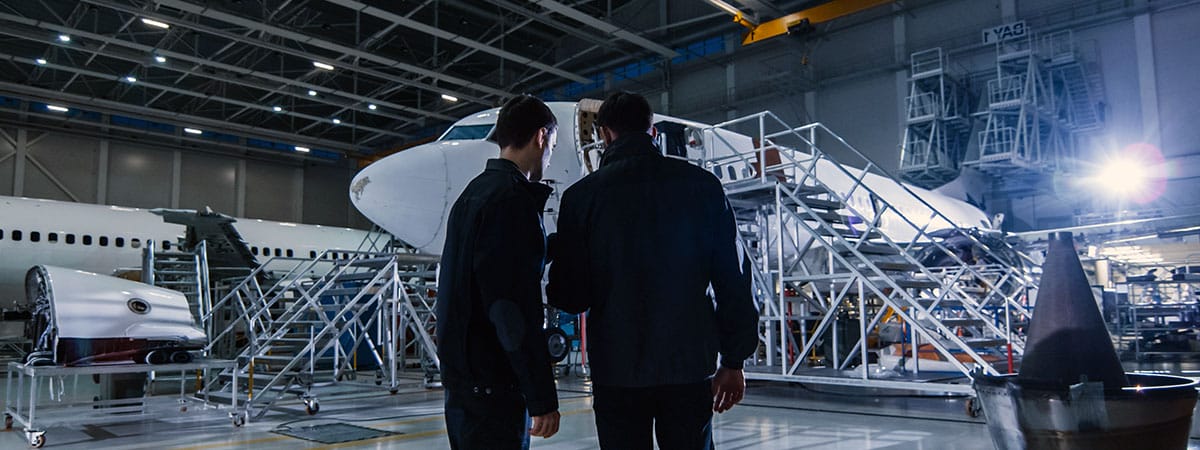Planes are truly a wonder of engineering, a testament to ingenuity and innovation. They were designed to overcome one of humankind’s natural barriers: flying. From the first aircraft sketches to the final product soaring through the sky, the process of designing and manufacturing a plane is a complex and meticulous journey involving hundreds of professionals and substantial resources.
Aviation clearly provides great benefits to society in which business, tourism, global availability of goods and job creation are variables in an equation whose results are always positive.
At the heart of every aircraft is an idea, a vision of flight, driving the engineers and designers to exceed the limits of what they already know.
It’s not just about getting something heavier than air to fly, but doing so, above all, safely and also while efficiently and profitably fulfilling the need the aircraft was created to meet.
The entire process, from conception to the time when the final aircraft departs the assembly line and flies into the sky, is called the “aircraft design process”. Let’s take a look at what’s involved and learn the steps necessary for an aircraft to go from conception to reality.
An aircraft design process begins with the conceptualisation of the aircraft to be produced. Before any ideas about what the aircraft will be like come up, the process begins with an exhaustive analysis of requirements and objectives. Whether it’s a commercial aircraft, a military aircraft, a private aircraft, or an uncrewed aircraft system (UAS), each process begins with a clear definition of the purpose of the aircraft, the missions it is being designed for, performance specifications and operational parameters. At this point, dialogue with the customer is vital, so the concept can be defined with all the details.
Aircraft designers work together with the stakeholders to specify the aircraft’s key characteristics and functionalities. At this stage, factors like payload capacity, autonomy, speed, fuel efficiency and passenger comfort are considered, as applicable. Preliminary sketches and conceptual designs sometimes help visualise the proposed design and polish initial ideas.
Once the conceptual basis has been set, focus moves to turning ideas into tangible designs, which we call the preliminary design. Engineers create detailed 3D models of the aircraft with various computer-aided design tools. The laws of aerodynamics come into play when designers shape the fuselage, wings and control surfaces to optimise lift, resistance and stability. It is also the time to test scale models in a wind tunnel and analyse behaviour.
Thrust systems, including engines and propellers, are incorporated into the design, along with avionics systems for navigation, communications and flight control. This is an iterative phase; the design is refined based on simulations, analysis and exchanging feedback with stakeholders.
Next comes the detail design phase for the future aircraft. Every component, from the landing gear to the interior furniture, is meticulously designed to meet regulatory safety and performance standards. Structural integrity is a primary concern and this is when the materials to be used for each component (aluminium, titanium, composite materials, etc.) are selected based on their resistance, weight, safety and durability.
Once the design is finalised, the prototyping and testing phase begins. It consists of building prototypes to validate the aircraft’s performance in real-world conditions. Although computer simulations have advanced significantly, wind tunnel testing remains essential. This testing allows engineers to assess aerodynamics and perfect the design of the fuselage. Structural testing simulates the tension and force seen during flight, ensuring the aircraft can bear the rigours of operation.
Flight tests are a critical part of the process of building prototypes. Experienced test pilots put the aircraft to the test to assess manoeuvrability, performance and safety. The data gathered during flight testing are analysed to identify any issues or areas for improvement, meaning the design continues to be perfected.
The next step is aircraft certification, which depends on the purpose it was built for. This means subjecting it to rigorous tests and assessments done by regulatory authorities to validate that the aircraft complies with strict airworthiness, safety and environmental compliance standards. These standards are established by organisations like the EASA (European Union Aviation Safety Agency) and the FAA (Federal Aviation Administration).
Certification tests involve comprehensive assessments of the aircraft’s systems, structures and characteristics. Manufacturers must prove compliance with a wide variety of regulations and standards ranging from resistance to bird impacts to noise emissions. Once it is certified, the plane receives authorisation for mass production and sale to customers.
Next comes the manufacturing or production phase, which is a highly coordinated process involving specialised facilities, highly qualified labour and advanced manufacturing technologies. Assembly lines are meticulously organised to guarantee efficient flow of components and subsets, carefully synching each stage of the process to fulfil very specific production objectives.
Materials on an aircraft come from suppliers from around the world, with strict quality control measures implemented to verify compliance with the specifications. This is complemented by the design and application of a traceability control system, which, in addition to ensuring regulatory compliance, allows processes to be improved, provides savings on production and logistics costs and ensures the quality of each part or set of parts.
Automated manufacturing techniques, like robotic assembly and laser cutting, streamline production and minimise errors. Throughout the manufacturing process, continuous oversight and inspection guarantee that each aircraft complies with the highest quality standards.
The assembly process lies at the heart of aircraft manufacturing; this is when individual components are joined to create a cohesive whole. Engineers and highly qualified professionals work together to assemble the aircraft structure, install thrust systems and integrate the avionics and other systems. Precision is paramount, with tolerances measured to the thousandth to guarantee adequate adjustment and alignment.
Once assembly is completed, the aircraft is subjected to a planned testing phase to verify functionality, performance and safety. Ground testing assesses systems like engines, hydraulics and avionics systems, guaranteeing that all components are operating as planned. Taxi tests allow pilots to assess the aircraft’s handling and brake performance on the ground.
An exhaustive inspection is carried out before the aircraft’s inaugural flight to identify any issues or discrepancies. Next, test pilots conduct a series of tests to validate the performance parameters and verify compliance with regulatory requirements. The data gathered during testing are analysed to identify areas for improvement and refining.
Once testing is completed and regulatory approval has been given, the aircraft is ready to be handed over to the customer. Regardless of whether it’s a commercial airline, a military organisation or a private owner, the handover process is carefully coordinated to guarantee problem-free delivery of the plane. Before this moment arrives, though, a thorough revision process is carried out by the customer in which their approval must be given.
After it is handed over, the aircraft manufacturer may provide continuous support and maintenance services to guarantee continuous airworthiness over the course of the aircraft’s operational life.
The aircraft design process is an amazing journey that takes the aircraft from conceptualisation to flight. It is a testament to human creativity, talent, innovation and perseverance. Designing and manufacturing aircraft is the culmination of decades of research, development and collaboration in a wide variety of disciplines of many thousands of highly qualified people.
This is a young industry that’s only been around for a century, but every day it is broadening its horizons and commitments. As has been mentioned previously on this blog, the next one is making aviation more and more sustainable every day. We’re working on it.



